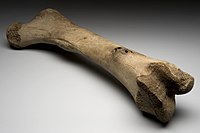
Photo from wikipedia
Background This study is to describe the design and surgical techniques of three- dimensional-printed porous implants for proximal giant cell tumors of bone and evaluate the short-term clinical outcomes. Methods… Click to show full abstract
Background This study is to describe the design and surgical techniques of three- dimensional-printed porous implants for proximal giant cell tumors of bone and evaluate the short-term clinical outcomes. Methods From December 2016 to April 2020, 8 patients with giant cell tumor of bone in the proximal tibia underwent intralesional curettage of the tumor and reconstruction with bone grafting and three-dimensional-printed porous implant. Detailed anatomy data were measured, including the size of lesion and thickness of the subchondral bone. Prostheses were custom-made for each patient by our team. All patients were evaluated regularly and short-term clinical outcomes were recorded. Results The mean follow-up period was 26 months. According to the different defect sizes, the mean size of the plate and mean length of strut were 35 × 35 mm and 20 mm, respectively. The mean affected subchondral bone percentage was 31.5%. The average preoperative and postoperative thickness of the subchondral bone was 2.1 mm and 11.1 mm, respectively. There was no wound infection, skin necrosis, peroneal nerve injury, or other surgical related complications. No degeneration of the knee joint was found. Osseointegration was observed in all patients. The MSTS improved from an average of 12 preoperatively to 28 postoperatively. Conclusion The application of three-dimensional-printed printed porous prosthesis combined autograft could supply enough mechanical support and enhance bone ingrowth. The design and operation management lead to satisfactory subchondral bone reconstruction.
Journal Title: Journal of Orthopaedic Surgery and Research
Year Published: 2021
Link to full text (if available)
Share on Social Media: Sign Up to like & get
recommendations!